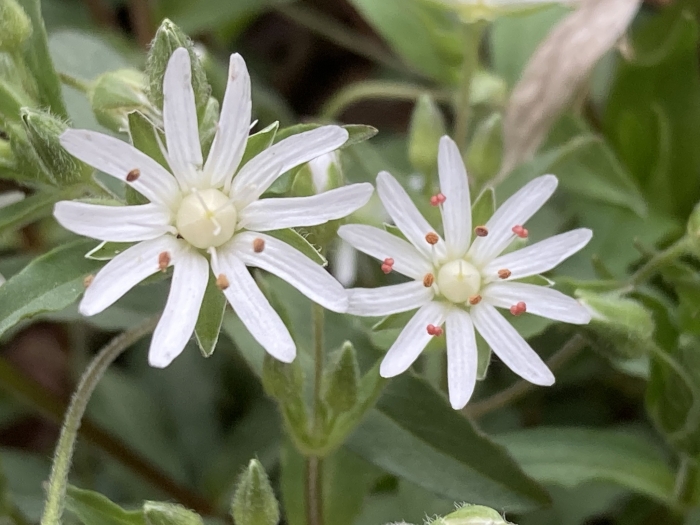Star Chickweed
(Stellaria pubera)
Star Chickweed (Stellaria pubera)
/
/

Hill Craddock
CC BY 4.0
Image By:
Hill Craddock
Recorded By:
Copyright:
CC BY 4.0
Copyright Notice:
Photo by: Hill Craddock | License Type: CC BY 4.0 | License URL: http://creativecommons.org/licenses/by/4.0/ | Rights Holder: Hill Craddock | Publisher: iNaturalist | Date Created: 2021-03-21T09:59:11-07:00 |











































































Estimated Native Range
Summary
Stellaria pubera, commonly known as Star Chickweed, is a deciduous perennial herb native to rich, deciduous woodlands and forest clearings in the Southeastern USA. This early spring bloomer can be seen flowering as early as late March, offering a delicate display when few other plants are in bloom. Star Chickweed typically grows 6 to 12 inches (15 to 30 cm) high. Its ovate leaves grow opposite one another, directly attached to the weak, sometimes reclining stems. The flowers are particularly noteworthy for their star-like appearance: what seems to be ten petals are in fact five deeply cleft petals, each split nearly to the base, resulting in a starburst of white, pointed segments around an off-white center. The stamens are tipped with dark anthers, adding contrast. The plant’s stems are lined with rows of small, soft hairs that switch sides at each node, a characteristic feature of this species.
Star Chickweed is valued for its early spring flowers, which can brighten woodland gardens and naturalized areas. It is often used as a ground cover or in border plantings, particularly in shaded garden spots where its moisture requirements can be met. It thrives in part shade, preferring moist, well-drained soils rich in organic matter. While it is not drought-tolerant, it can be a low-maintenance addition to the right environment. Gardeners should be aware that in optimal conditions, Star Chickweed can spread readily, though it is not typically aggressive or invasive.CC BY-SA 4.0
Star Chickweed is valued for its early spring flowers, which can brighten woodland gardens and naturalized areas. It is often used as a ground cover or in border plantings, particularly in shaded garden spots where its moisture requirements can be met. It thrives in part shade, preferring moist, well-drained soils rich in organic matter. While it is not drought-tolerant, it can be a low-maintenance addition to the right environment. Gardeners should be aware that in optimal conditions, Star Chickweed can spread readily, though it is not typically aggressive or invasive.CC BY-SA 4.0
Plant Description
- Plant Type: Herb
- Height: 0.5-1 feet
- Width: 0.5-1.5 feet
- Growth Rate: Moderate
- Flower Color: White
- Flowering Season: Spring
- Leaf Retention: Deciduous
Growth Requirements
- Sun: Part Shade
- Water: High
- Drainage: Fast
Common Uses
Bank Stabilization, Bee Garden, Bird Garden, Edible*Disclaimer: Easyscape's listed plant edibility is for informational use. Always verify the safety and proper identification of any plant before consumption., Groundcover, Low Maintenance, Showy Flowers
Natural Habitat
Rich, deciduous woodlands and forest clearings in the Southeastern USA
Other Names
Common Names:
Scientific Names: , Stellaria pubera, Alsine pubera var. tennesseensis, Alsine pubera, Stellaria pubera subsp. homotricha, Stellaria pubera subsp. typica,
GBIF Accepted Name: Stellaria pubera Michx.